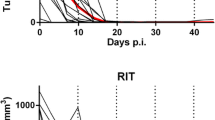Summary
A long-term-cultured cytotoxic T lymphocyte (CTL) line (E/88) was obtained from splenic lymphocytes of BALB/c (H-2 d) mice bearing the weakly immunogenic colonic carcinoma C26. This line was shown to be α/βTCR+Vβ6+CD3+CD8+CD4− and to recognize a common tumour-associated antigen on syngeneic carcinomas and sarcomas in a major-histocompatibility—complex-restricted and T-cell-receptor(TCR)-mediated fashion. The assessment of cytotoxic activity on a panel of 30 normal and neoplastic target cells of differing etiology and histotype showed that E/88 CTL lysed syngeneic colon carcinomas and some fibrosarcomas but not leukemias, lymphomas or mammary carcinomas. Clones derived from the E/88 line exhibited the same lytic pattern. Moreover, anti-T3, anti-Lyt2.2, anti-α/βTCR and anti-Vβ6 mAbs as well as anti-H-2d antisera abolished cytotoxicity when used in blocking experiments. The therapeutic activity of E/88 CTL upon in vivo transfer was assessed in mice bearing either experimental or spontaneous metastases of C26. In both models therapy with E/88 lymphocytes in combination or not with interleukin-2 was highly effective. Adoptive immunotherapy carried out with two clones obtained from line E/88 showed comparable therapeutic effects. In addition, treatment of syngeneic mice bearing experimental metastases of in vitro E/88-lysable or E/88-resistant tumours, showed that E/88 CTL can eradicate metastases of the former but not of the latter neoplasms. These data indicate that long-term CTL lines recognizing common tumour-associated antigens can be derived from tumourbearing animals and used in adoptive immunotherapy of tumours previously shown to be lysed in vitro by these effectors.
Similar content being viewed by others
References
Belnap LP, Cleveland PH, Colmerauer MEM, Barone RM, Pilch YH (1979) Immunogenicity of chemically induced colon cancers. Cancer Res 39: 1174
Carbone G, Pierotti MA, Boiocchi M, De Leo AB, Ballinari D, Radice P, Borrello MG, Meseguer A, Cernuschi A, Parmiani G (1985) Cell surface antigens of chemically induced fibrosarcomas: detection by a monoclonal antibody of a tumor-restricted Mr 12,000 proteingag antigen encoded by a dual-tropic murine leukemia virus. Cancer Res 45: 4980
Chou T, Chang AE, Shu S (1988) Generation of therapeutic T lymphocytes from tumor-bearing mice by in vitro sensitization. J Immunol 140: 2453
Darrow TL, Slingluff CL, Seigler HF (1989) The role of HLA class I antigens in recognition of melanoma cells by tumor-specific cytotoxic T-lymphocytes: evidence for shared tumor antigens. J Immunol 142: 3329
Greenberg PD, Klarnet JP, Kern DE, Cheever MA (1988) Therapy of disseminated tumors by adoptive transfer of specifically immune T cells. Prog Exp Tumor Res 32: 104
Hearing VJ, Gersten DM, Montague PM, Vierea WD, Galetto G, Law LW (1986) Murine melanoma-specific tumor rejection activity elicited by a purified melanoma associated antigen. J Immunol 137: 379
Hellstrom KE, Hellstrom I, Brown J (1978) Unique and common tumor-specific transplantation antigens of chemically induced mouse sarcomas. Int J Cancer 21: 317
Law LW (1984) Generation of cross-reacting tumor antigens in ascitic derivatives from murine methylcholanthrene-induced sarcomas. Int J Cancer 33: 547
Leffel MS, Coggin JH (1977) Common transplantation antigens on methylcholanthrene-induced murine sarcomas detected by three assays of tumor rejection. Cancer Res 37: 4112
Morishita H, Shiku H, Horibe K, Obata Y, Stockert E, Oettgen HF, Old LJ, Yamada K (1986) Cell surface antigens of murine leukemias induced by radiation leukemia virus. Recognition of individually distinct cell surface antigens by cytotoxic T cells on leukemias expressing cross-reactive transplantation antigens. J Exp Med 163: 452
Parmiani G, Sensi ML, Balsari A, Colombo MP, Gambacorti-Passerini C, Grazioli L, Rodolfo M, Cascinelli N, Fossati G (1986) Adoptive immunotherapy of cancer with immune and activated lymphocytes: experimental and clinical studies. Ric Clin Lab 16: 1
Parmiani G, Grazioli L, Sensi M, Colombo MP, Rodolfo M (1987) Treatment of a low immunogenic experimental tumor with alloactivated or tumor-immune lymphocytes. Biochim Biophys Acta 907: 163
Rodolfo M, Parmiani G (1987) Growth inhibition of murine colonic adenocarcinoma by tumor immune but not by IL-2-activated or alloactivated lymphocytes. Tumori 73: 1
Rodolfo M, Salvi C, Parmiani G (1989) Influence of the donors' clinical status on in vitro and in vivo tumor-cytotoxic activation of interleukin-2-exposed lymphocytes and their circulation in different organs. Cancer Immunol Immunother 28: 136
Rodolfo M, Salvi C, Bassi C, Parmiani G (1990) Adoptive immunotherapy of a mouse colon carcinoma with recombinant interleukin-2 alone or combined with lymphokine-activated killer cells or tumor-immune lymphocytes. Cancer Immunol Immunother 31: 28
Rodolfo M, Salvi C, Bassi C, Rovetta G, Melani C, Colombo MP, Parmiani G (1991) Adjuvant adoptive immunotherapy with IL-2 and lymphocytes from tumor-bearing mice: in vitro tumor-stimulated lymphocytes are more effective than LAK cells. Nat Immun Cell Growth Regul (in press)
Rosenberg SA (1985) Lymphokine-activated killer cells: a new approach to immunotherapy of cancer. J Natl Cancer Inst 75: 595
Rosenberg SA, Spiess P, Lafreniere R (1986) A new approach to the adoptive immunotherapy of cancer with tumor-infiltrating lymphocytes. Science 233: 1318
Sakai K, Chang AE, Shu S (1990) Effector phenotype and immunologic specificity of T-cell mediated adoptive therapy for a murine tumor that lacks intrinsic immunogenicity. Cell Immunol 129: 241
Sato N, Kikuki K (1985) Partial characterization ofn-butanol-solubilized rejection-type antigens on syngeneic murine colon tumors. J Natl Cancer Inst 74: 883
Shu S, Chou T, Sakai K (1989) Lymphocytes generated by in vivo priming and in vitro sensitization demonstrate therapeutic efficacy against a murine tumor that lacks apparent immunogenicity. J Immunol 143: 780
Slovin SF, Lackman RD, Ferrone S, Kiely PE, Mastrangelo MJ (1986) Cellular immune response to human sarcomas: cytotoxic T cell clones reactive with autologous sarcomas. J Immunol 137: 3042
Spiess PJ, Yang JC, Rosenberg SA (1987) In vivo antitumor activity of tumor-infiltrating lymphocytes expanded in recombinant interleukin-2. J Natl Cancer Inst 79: 1067
Author information
Authors and Affiliations
Rights and permissions
About this article
Cite this article
Rodolfo, M., Bassi, C., Salvi, C. et al. Therapeutic use of a long-term cytotoxic T cell line recognizing a common tumour-associated antigen: The pattern of in vitro reactivity predicts the in vivo effect on different tumours. Cancer Immunol Immunother 34, 53–62 (1991). https://doi.org/10.1007/BF01741325
Received:
Accepted:
Issue Date:
DOI: https://doi.org/10.1007/BF01741325




